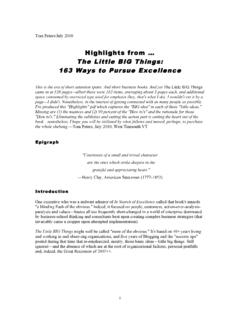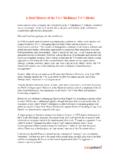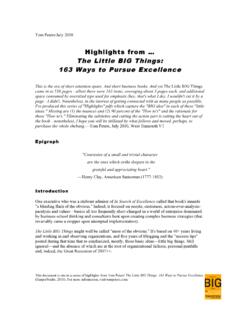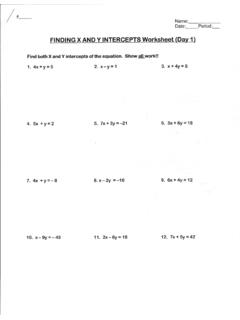Transcription of STRUCTURE IS NOT ORGANIZATION - Tom Peters
1 STRUCTURE IS NOT ORGANIZATION Diagnosing and solving organizational problems means looking not merely to structural reorganization for answers but to a framework that includes STRUCTURE and several related factors. 14 ROBERT H. WATERMAN, JR., THOMAS J. Peters , A N D JULIEN R. PHILLIPS T h e Belgian surrealist Ren~ Magritte painted a series of pipes and titled the series Ceci n'est pas une pipe: this is not a pipe. The picture of the thing is not the thing. In the same way, a s t r u c t u r e is not an ORGANIZATION . We all know that, but like as not, when we reorganize what we do is to restructure. Intellectually all managers and consultants know that much more goes on in the process of organizing than the charts, boxes, dotted lines, position descriptions, and matrices can possibly depict.
2 But all too often we behave as though we didn't know it; if we want change we change the STRUCTURE . Early in 1977, a general concern with the problems of ORGANIZATION effectiveness, and a ROBERT H. WATERMAN, JR. is a Director, THOMAS J. Peters a Principal, and JULIEN R. PHILLIPS an Associate in the San Francisco office of McKinsey & Company. Mssrs. Waterman and Peters are co-leaders of McKinsey's Organizational Effective- ness practice. particular concern about the nature of the relationship between STRUCTURE and o r g a n i z a - tion, led us to assemble an internal task force to review our client work. T h e natural first step was to talk extensively to consultants and client executives around the world who were known for their skill and experience in ORGANIZATION design.
3 We found that they too were dissatisfied with conventional ap- proaches. All were disillusioned about the u s u a l structural solutions, but they were also skeptical about anyone's ability to do b e t t e r . In their e x p e r i e n c e , the techniques of the behavioral sciences were not providing useful alternatives to structural design. True, the notion that STRUCTURE follows strategy (get the strategy right and the STRUCTURE follows) The authors want to offer special acknowledgement and thanks to Anthony G. Athos of Harvard Universi- ty, who was instrumental in the development of the 7-S framework and who, in his capacity as our consultant, helped generally to advance our thinking on ORGANIZATION effectiveness.
4 BUSINESS HORIZONS STRUCTURE Is Not ORGANIZATION looked like an important addition to the organizational tool kit; yet strategy rarely seemed to dictate unique structural solutions. Moreover, the main problem in strategy had turned out to be execution: getting it done. And that, to a very large extent, meant ORGANIZATION . So the problem of ORGANIZATION effectiveness threatened to prove circular. The dearth of practical additions to old ways of thought was painfully apparent. OUTSIDE EXPLORATIONS Our next step was to look ouside for help. We visited a dozen business schools in the United States and Europe and about as many su- perbly performing companies. Both academic theorists and business leaders, we found, were wrestling with the same concerns.
5 Our timing in looking at the academic environment was good. The state of theory is in great turmoil but moving toward a new consensus. Some researchers continue to write about STRUCTURE , particularly its latest and most modish variant, the matrix ORGANIZATION . But primarily the ferment is around another stream of ideas that follow from some start- ling premises about the limited capacity of decision makers to process information and reach what we usually think of as "rational" decisions. The stream that today's researchers are tapping is an old one, started in the late 1930s by Fritz Roethlisberger and Chester Barnard, then both at Harvard (Barnard had been president of New Jersey Bell).
6 They chal- lenged rationalist theory, first-in Roethlis- berger's case-on the shop floors of Western Electric's Hawthorne plant. Roethlisberger found that simply paying attention provided a stimulus to productivity that far exceeded that induced by formal rewards. In a study of workplace hygiene, they turned the lights up and got an expected productivity increase. Then to validate their results they turned the lights down. But something surprising was wrong: productivity went up again. Atten- tion, they concluded, not working conditions per se, made the difference. Barnard, speaking from the chief execu- tive's perspective, asserted that the CEO's role is to harness the social forces in the organiza- tion, to shape and guide values.
7 He described good value-shapers as effective managers, con- trasting them with the mere manipulators of formal rewards who dealt only with the narrower concept of efficiency. Barnard's words, though quickly picked up by Herbert Simon (whom we'll come back to later), lay dormant for thirty years while the primary management issues focused on decentralization and STRUCTURE -the appropri- ate and burning issue of the time. But then, as the decentralized STRUCTURE proved to be less than a panacea for all time, and its substitute, the matrix, ran into worse trouble, Barnard's and Simon's ideas triggered a new wave of thinking. On the theory side, it is exemplified by the work of James March and Karl Weick, who attacked the rational model with a vengeance.
8 Weick suggests that organizations learn-and adapt-very slowly. They pay obsessive attention to internal cues long after their practical value has ceased. Important business assumptions are buried deep in the minutiae of organizational sys- tems and other habitual routines whose ori- gins have been long obscured by time. March goes further. He introduced, only slightly facetiously, the garbage can as an organiza- tional metaphor. March pictures ORGANIZATION - al learning and decision making as a stream of choices, solutions, decision makers, and op- portunities interacting almost randomly to make decisions that carry the ORGANIZATION toward the future. His observations about large organizations parallel Truman's about the presidency: "You issue orders from this office and if you can find out what happens to them after that, you're a better man than I am.
9 " Other researchers have accumulated data which support this unconventional view. 15 JUNE 1980 ROBERT H. WATERMAN, JR., THOMAS J. Peters , AND JULIEN R. PHILLIPS "In the face of complexity and multiple competing demands, organiza- tions simply can't handle decision-making in a totally rational way. Not surprisingly, then, a single blunt instrument like structuremis unlikely to prove the master tool that can change organizations with best effect." 16 Henry Mintzberg made one of the few rigor- ous studies of how senior managers actually use time. They don't block out large chunks of time for planning, organizing, motivating, and controlling as some suggest they should. Their time, in fact, is appallingly but perhaps necessarily fragmented.
10 Andrew Pettigrew studied the politics of strategic decision and was fascinated by the inertial properties of organizations. He showed that organizations frequently hold onto faulty assumptions about their world for as long as a decade, despite overwhelming evidence that it has changed and they probably should too. In sum, what the researchers tell us is: "We can explain why you have problems." In the face of complexity and multiple com- peting demands, organizations simply can't handle decision making in a totally rational way. Not surprisingly, then, a single blunt instrument-like STRUCTURE -is unlikely to prove the master tool that can change organi- zations with best effect.









